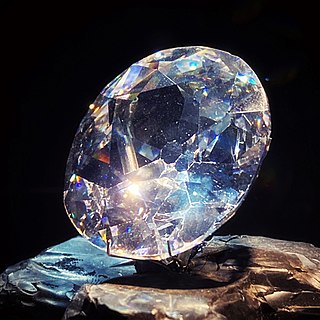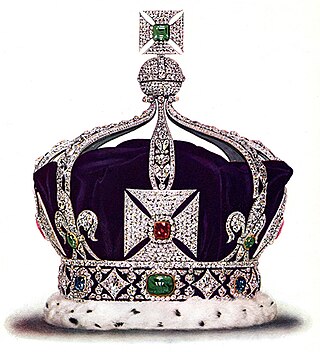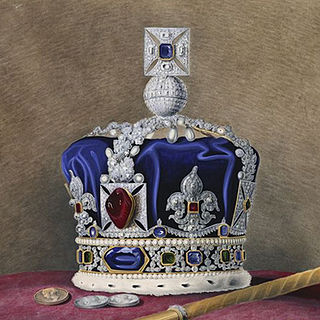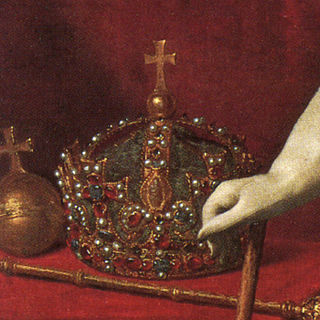
The Stuart Sapphire is a blue sapphire that forms part of the British Crown Jewels. It weighs 104 carats (20.8 grams) and is believed to have originated from Asia, potentially present-day Afghanistan, Sri Lanka, Myanmar or Kashmir. [1]

The Stuart Sapphire is a blue sapphire that forms part of the British Crown Jewels. It weighs 104 carats (20.8 grams) and is believed to have originated from Asia, potentially present-day Afghanistan, Sri Lanka, Myanmar or Kashmir. [1]
The early history of the gem is quite obscure, though it probably belonged to Charles II, and was definitely among the jewels that his successor James VII and II took with him when he fled to France after the Glorious Revolution in December 1688. [2]
From there it passed to his son, James Stuart (the 'Old Pretender') who bequeathed it to his son, Henry Benedict, known later as Cardinal York, who wore it in his mitre. [3]
As the last descendant of James VII and II, the cardinal put the sapphire, along with many other Stuart relics, up for sale. It was purchased by George III in 1807 and returned to the United Kingdom from Italy. [4]
On the Imperial State Crown of Queen Victoria, the jewel took pride of place at the front of the circlet, just below the Black Prince's Ruby.
In 1909, during the reign of Edward VII, it was moved to the back of the crown to make way for the 317-carat (63.4 g) Cullinan II diamond; it still occupies that position in the back of the Imperial State Crown made in 1937 (a copy of Victoria's) and used by Charles III. [5]
The Stuart Sapphire is on public display with the other Crown Jewels in the Jewel House at the Tower of London.
The sapphire weighs 104-carat (20.8 g). It is oval-shaped, about 3.8 cm (1.5 in) long and 2.5 cm (1.0 in) wide, and has one or two blemishes but was evidently deemed to be of high value by the Stuarts. At some point a hole was drilled at one end, probably to introduce an attachment by which the stone could be worn as a pendant. [2]
On the back is a miniature plaque engraved with a short history of the Imperial State Crown. [5]

The Koh-i-Noor, also spelled Koh-e-Noor,Kohinoor and Koh-i-Nur, is one of the largest cut diamonds in the world, weighing 105.6 carats (21.12 g). It is part of the Crown Jewels of the United Kingdom. The diamond is currently set in the Crown of Queen Elizabeth The Queen Mother.

Emperor or Empress of India was a title used by British monarchs from 1 May 1876 to 22 June 1948 to signify their sovereignty over the Indian Empire as its imperial head of state. The image of the emperor or empress appeared on Indian currency, in government buildings, railway stations, courts, on statues etc. Oaths of allegiance were made to the emperor or empress and the lawful successors by the governors-general, princes, governors, commissioners in India in events such as imperial durbars.

The Cullinan Diamond is the largest gem-quality rough diamond ever found on Earth, weighing 3,106 carats (621.20 g), discovered at the Premier No.2 mine in Cullinan, South Africa, on 26 January 1905. It was named after Thomas Cullinan, the owner of the mine. In April 1905, it was put on sale in London, but despite considerable interest, it was still unsold after two years. In 1907, the Transvaal Colony government bought the Cullinan and Prime Minister Louis Botha presented it to Edward VII, the British king who reigned over the territory, and it was cut by Joseph Asscher & Co. in Amsterdam.

The Imperial Crown of India was used by King George V in his capacity as Emperor of India at the Delhi Durbar of 1911.

The Crown Jewels of the United Kingdom, originally the Crown Jewels of England, are a collection of royal ceremonial objects kept in the Jewel House at the Tower of London, which include the coronation regalia and vestments worn by British monarchs.

St Edward's Crown is the centrepiece of the Crown Jewels of the United Kingdom. Named after Saint Edward the Confessor, versions of it have traditionally been used to crown English and British monarchs at their coronations since the 13th century.

The Imperial State Crown is one of the Crown Jewels of the United Kingdom and symbolises the sovereignty of the British monarch. It has existed in various forms since the 15th century. The 1937 version is worn by a new monarch for the first time in the royal procession following their coronation and subsequently used at State Openings of Parliament. The crown is adorned with 2,901 precious stones, including the Cullinan II diamond, St Edward's Sapphire, the Stuart Sapphire, and the Black Prince's Ruby.

The Honours of Scotland, informally known as the Scottish Crown Jewels, are the regalia that were worn by Scottish monarchs at their coronation. Kept in the Crown Room in Edinburgh Castle, they date from the 15th and 16th centuries, and are the oldest surviving set of crown jewels in the British Isles.

The Black Prince's Ruby is a large, irregular cabochon red spinel weighing 170 carats (34 g) set in the cross pattée above the Cullinan II diamond at the front of the Imperial State Crown of the United Kingdom. The spinel is one of the oldest parts of the Crown Jewels of the United Kingdom, with a history dating back to the middle of the 14th century. It has been in the possession of England's rulers since it was given in 1367 to its namesake, Edward of Woodstock. The stone is believed to have originated from the Badakhshan mines in present day Afghanistan and Tajikistan, the principal source of large spinel gems in the Middle Ages.

The Imperial crown of Russia, also known as the great imperial crown, was used for the coronation of the monarchs of Russia from 1762 until the Russian monarchy's abolition in 1917. The great imperial crown was first used in the coronation by Catherine the Great, and it was last worn at the coronation of Nicholas II. It was displayed prominently next to Nicholas II on a cushion at the State Opening of the Russian Duma inside the Winter Palace in St. Petersburg in 1906. It survived the 1917 revolution and ensuing civil war and is currently on display in Moscow at the Kremlin Armoury's State Diamond Fund.

The State Crown of George I is the imperial and state crown crafted in 1714 for King George I. It was modified and used by subsequent monarchs until 1838. The empty gold frame and its aquamarine monde which dates from the reign of King James II are both part of the Crown Jewels of the United Kingdom. They are on public display in the Martin Tower at the Tower of London.

The Iranian National Jewels, originally the Iranian Crown Jewels, include elaborate crowns, thirty tiaras, and numerous aigrettes, a dozen bejeweled swords and shields, a number of unset precious gems, numerous plates and other dining services cast in precious metals and encrusted with gems, and several other more unusual items collected or worn by the Persian monarchs from the 16th century and on. The collection is housed at the Treasury of National Jewels, situated inside the Central Bank of Iran on Tehran's Ferdowsi Street.

The Crown of Queen Mary is a consort crown that was made in 1911 for the coronation of British queen Mary of Teck. Mary thereafter wore it on occasion in circlet form. It is part of the Crown Jewels of the United Kingdom. It was used again, in a slightly altered form, at the coronation of Queen Camilla on 6 May 2023.

The Bohemian crown jewels, also called the Czech crown jewels, include the Crown of Saint Wenceslas, the royal orb and sceptre, the coronation vestments of the Kings of Bohemia, the gold reliquary cross, and St. Wenceslas' sword. They were originally held in Prague and Karlštejn Castle, designed in the 14th century by Matthias of Arras. Since 1791 they have been stored in St. Vitus Cathedral at Prague Castle. Reproductions of the jewels are permanently exhibited in the historical exposition at the former royal palace in the castle. The crown was made for the coronation of Charles IV in 1347, making it the fourth oldest in Europe.

The Small Diamond Crown of Queen Victoria is a miniature imperial and state crown made at the request of Queen Victoria in 1870 to wear over her widow's cap following the death of her husband, Prince Albert. It was perhaps the crown most associated with the queen and is one of the Crown Jewels on public display in the Jewel House at the Tower of London.

The Napoleon Tiara was a papal tiara given to Pope Pius VII in June 1805 a few months after he presided at the coronation of Napoleon I and Joséphine de Beauharnais. While lavishly decorated with jewels, it was deliberately too small and heavy to be worn and meant as an insult to the Pope. In the painting of The Coronation of Napoleon by Jacques-Louis David, the tiara is held behind the Pope by one of his aides.

St Edward's Sapphire is an octagonal rose-cut sapphire that forms part of the British Crown Jewels.

Queen Elizabeth II owned a historic collection of jewels – some as monarch and others as a private individual. They are separate from the gems and jewels of the Royal Collection, and from the coronation and state regalia that make up the Crown Jewels.

The Tudor Crown, also known as Henry VIII's Crown, was the imperial and state crown of English monarchs from around the time of Henry VIII until it was destroyed during the Civil War in 1649. It was described by the art historian Sir Roy Strong as "a masterpiece of early Tudor jeweller's art", and its form has been compared to the crown of the Holy Roman Empire.